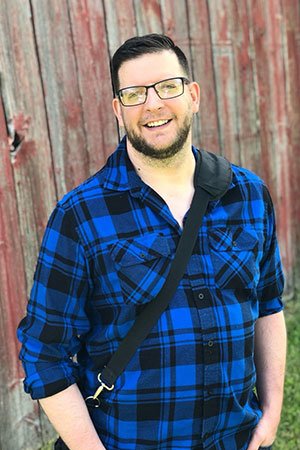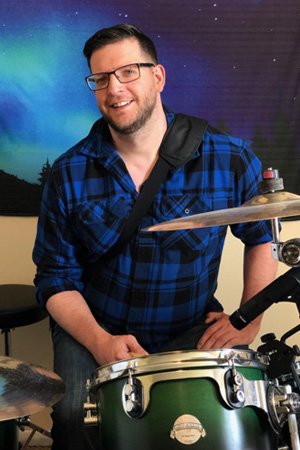Building Hope
 After his first heart procedure, Chad Williams thought he was fine.
After his first heart procedure, Chad Williams thought he was fine.
“I had an electrical issue, an extra node that was causing my heart to palpitate and beat erratically,” says Chad, who lives near Midland, Michigan.
In his twenties he had a procedure to fix this. He didn’t have any other symptoms for over a decade, until he started experiencing shortness of breath one night.
“It woke me up out of my sleep, but I brushed it off at first,” Chad says. “Then I started having chest pains. I went to my primary care physician to get it checked out, and was referred to a specialist.”
It was a couple of weeks before the specialist could see him, so Chad went back to work. The first night there, he had more chest pains, which progressed through the night, until he went to his local emergency room.
A complete shock
“At the ER, they diagnosed me with heart failure,” Chad says. “I was completely shocked, in disbelief, but I tried to remain as positive as I could.”
His heart failure was so severe that Chad needed a valve repair. He was transferred by ambulance for the two-hour drive to Henry Ford Hospital, one of few facilities in Michigan that could do this procedure. At Henry Ford, he met with the heart team, and they told him that in addition to the valve repair, they would need to place a sleeve on his aortic aneurysm.
The aorta is the largest artery in the body, and it runs from the heart down to the abdomen, supplying blood to the body. When the wall of this blood vessel weakens, it can form an aneurysm, or bulge. If it ruptures, it can cause potentially fatal internal bleeding.
In Chad’s case, the Henry Ford team had seen the aneurysm on the X-ray, and told him that this is what had caused the heart failure over time.
They also let Chad know they were keeping a left ventricular assist device (LVAD) implant as a backup option, in case he did not go through the surgery as planned. An LVAD is a mechanical device that is implanted on the left side of the heart. It helps a weakened heart pump blood to the rest of the body, and it can serve as a bridge to heart transplant.
Ultimately, the surgical team didn’t need to implant the LVAD at this time, and Chad was placed on several medications.
Back to surgery
“After surgery, I did need to be readmitted due to excess water retention in my body,” he says. “But for several weeks after being discharged, I started doing physical therapy at home and I was feeling much better. I was also cleared to live on my own again, instead of needing my mother to stay with me and help around the house.”
So it was once again a shock when Chad found himself back at Henry Ford.
“Even with the surgery and medication, my heart was unable to recover from the failure damage and I was readmitted to Henry Ford Hospital on December 22,” Chad says. “It definitely wasn’t the way I had planned to spend Christmas, or New Year’s.”
Two weeks later, Chad underwent LVAD surgery, and his was a complex case.
“Because I had previous open chest surgery, they couldn’t do the normal procedure to place the LVAD,” he says. “Instead, they had to go through my ribs, and this was much more painful. I was in the hospital for over a month.”
As he worked through his recovery, Chad started to feel a little better, but it was a slow process. He had support from his Henry Ford heart team.
 “Nothing is truly easy after heart surgery,” Chad says. “I appreciated people like Dr. Cowger, who was very down to earth and straightforward in telling me what to expect. And Dr. Tita, who was a stickler about wanting me to do better and push myself more. At one point, she bet me a bagel that I would not be able to do a certain exercise. The next day, I won the bagel.”
“Nothing is truly easy after heart surgery,” Chad says. “I appreciated people like Dr. Cowger, who was very down to earth and straightforward in telling me what to expect. And Dr. Tita, who was a stickler about wanting me to do better and push myself more. At one point, she bet me a bagel that I would not be able to do a certain exercise. The next day, I won the bagel.”
His care team had also prepped him on what to expect in living with and maintaining an LVAD.
“It took me a fair amount of time to get used to it,” Chad says. “It’s a complete lifestyle change. But after the initial shock and worry, it’s second nature now.”
Looking forward
Still, as much as he has gotten used to his LVAD and appreciates it, Chad is hopeful for the day when he can get a new heart, and live a life without wires.
“I was less shocked than most people would be about needing a heart transplant,” he says. “I have a very close friend who had a kidney transplant, so I know what to expect, to an extent.”
A year later, he’s also thankful for the support he’s received throughout his treatment from his family.
“My family’s been there for me through it all, giving me the love that I needed, helping to keep me going. When you experience something like this, you learn how short and fragile life really is, and try not to let small things bother you as much.”
.svg?iar=0&hash=F6049510E33E4E6D8196C26CCC0A64A4)

/hfh-logo-main--white.svg?iar=0&hash=ED491CBFADFB7670FAE94559C98D7798)